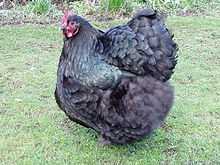Orpington (chicken)
| Orpington | |
|---|---|
 A Black Orpington hen | |
| Conservation status | Recovering |
| Country of origin | England |
| Traits | |
| Weight | Male: 10 lbs / 4.5 kg (Large) |
| Female: 8.5 lbs / 3.6 kg (Large) | |
| Skin color | white |
| Egg color | Light brown |
| Comb type |
Medium Single Notes:The Orpington is great with children and other breeds of chicken |
| Classification | |
| APA | English |
| ABA | yes |
|
Chicken Gallus gallus domesticus | |
The Orpington is a breed of chicken named after Orpington, England,[1] which was made famous in part by this breed. Belonging to the English class of chickens, it was bred to be an excellent layer with good meat quality.[2] Their large size and soft appearance together with their rich color and gentle contours make them very attractive, and as such its popularity has grown as a show bird rather than a utility breed. They go broody very often, and make great mothers. Although rather heavy, they are able to fly small distances but rarely do,[3] so they work well as backyard birds. Due to their build they do well in very cold climates.
History

The original Black Orpington was bred by William Cook in 1886 by crossing Minorcas, Langshans and Plymouth Rocks to create a new hybrid bird. Cook selected a black bird that would exhibit well by hiding the dirt and soot of London.[4] When the breed was shown in Madison Square Gardens in 1895, its popularity soared.[5] Cook also gave this name to a breed of duck with a similar purpose, but known simply as the Buff Duck in North America.
The original colors are black, white, buff, blue and splash. Although there are many additional varieties recognized throughout the world, only the original colors are recognized by the American Standard, the Buff being the most common color.[6] In the beginning of the twentieth century, Herman Kuhn of Germany developed a Bantam variety.[7] The Bantam retains the large appearance, but in a smaller size. Like the Standard varieties, there is a large variety of colors in the Bantam version (i.e. black, blue laced, white, buff, red, buff black laced, barred, buff Columbian, and birchen.)[8] The Bantam retains the friendly personality of the Standard breed, and seldom or never flies, so it too makes for a breed for children and backyards.[9]
Appearance

The Orpington has a heavy, broad body with a low stance, and the down from their body covers most of their legs.
Some characteristics of an Orpington are:
- Heavy weight (7 to 10 pounds),
- Soft, profuse feathering, which almost hides the legs of the bird,
- Curvy shape with a short back and U-shaped underline,
- A small head with a medium single comb.
- Large and usually easily tamed
- Fluffy feathers making it look distinctively large.
Approximate weight (metric)
| Rooster | 4.5 kg | 9.9 lbs |
| Hen | 3.6 - 4.8 kg | 7.9 - 10.6 lbs |
| Cockerel | 3.8 kg | 8.4 lbs |
| Pullet | 3.2 kg | 7 lbs |
| Rooster | 2.0 kg | 4.4 lbs |
| Hen | 1.6 kg | 3.5 lbs |
Utility
Orpingtons lay about 175 to 200[10] medium to large[11] light-brown eggs a year. They do not stop laying in the winter.
It was said that at one time Orpingtons were capable of laying as many as 340[12] eggs per year. This decline in production was due to breeders selecting for looks over utility.[13]
The chickens also get large, so they are suited for eating and make great mothers. All of these qualities make them perfect Homestead chickens.
Clubs
The United Orpington Club is the American club dedicated to all Orpingtons, Large Fowl and Bantam, and to the breeders of this fine fowl in America. The Orpington Club of Australia is the Australian club that supports the Orpington breed in Australia. In the U.K. there are two clubs, The Orpington Club and The Orpington Bantam Club.
See also
Footnotes
- ↑ (Percy 2006, pp. 115)
- ↑ (Percy 2006, pp. 115)
- ↑ (Verhoff 2003, pp. 158)
- ↑ (Verhoff 2003, pp. 158)
- ↑ (Percy 2006, pp. 115)
- ↑ (Ekarius 2007, pp. 98)
- ↑ (Verhoff 2003, pp. 254)
- ↑ (Verhoff 2003, pp. 254)
- ↑ (Verhoff 2003, pp. 254)
- ↑ (Verhoff 2003, pp. 158)
- ↑ (Percy 2006, pp. 115)
- ↑ (Percy 2006, pp. 115)
- ↑ (Ekarius 2007, pp. 98)
References
- Ekarius, Carol (2007). Storey's Illustrated Guide to Poultry Breeds. 210 MAS MoCA Way, North Adams MA 01247: Storey Publishing. ISBN 978-1-58017-667-5.
- Percy, Pam (2006). The Field Guide to CHICKENS. Suite 200, 380 Jackson Street, St. Paul, MN 55101-3885: Voyageur Press. ISBN 0-7603-2473-5.
- Verhoff, Esther (2003). The Complete Encyclopedia of Chickens. Lisse, Netherlands: Rebo International. ISBN 978-90-366-1592-1.
- The Orpington Club of G.B.
- The Orpington Bantam Club of G.B.
- The Orpington Club of Australia
- The United Orpington Club
- USA Lavender Orpington:~2007